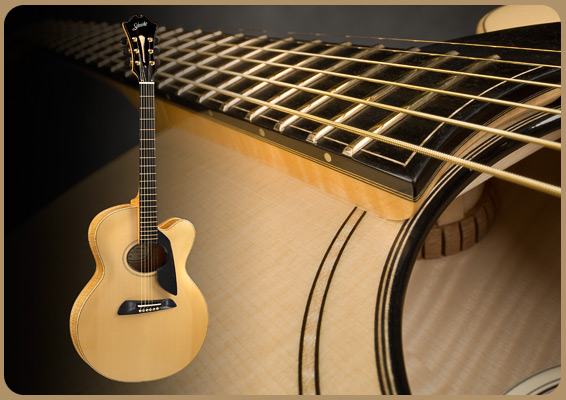


This arch top guitar is a one of a kind masterpiece that was made especially for a collector who appreciates one of a kind, handmade "Art" guitars. It took Schneider at least two thousand hours and two years to design and build this guitar by hand without the help of any computers or carving machines.
This instrument is unique in many ways. The glued on bridge on an arch top is a concept Orville Gibson invented in 1898. It was the “first” arch top guitar ever made and oddly enough, the design has been ignored for over a century. Orville’s instrument was overbuilt and didn’t have great sound qualities but, in Schneider's opinion, his idea was worth pursuing. The sound is a cross between an arch top and a flat top since the tension is emanating from one fixed point on the soundboard like a flat top instead of the traditional "tailpiece" arch top design. The sound is like no other guitar on the market today. The sound is even everywhere on the fingerboard and has sustain and clarity like that of a piano.
The bracing is the “Circle of Sound” bracing Jimmy D’Aquisto showed Schneider in the 1970’s. It is an X brace with braces glued around the X that forms a circle to give incredible tone colors. It has a compound curved maple bridge plate to accommodate the bone bridge pins. Each brace had to be fit exactly to the compound curve of the underside of the soundboard and “tuned” along with the frequency of the soundboard with the use of “tap tones” before the top was glued on the sides. The curly ebony bridge had to be fit to the compound curves of the top with ultimate precision and much patience.
The top and back plates are thinly carved with two compound arches with no “re-curve” like a normal arch top. The result is a sound that resembles a grand piano. The clarity and sustain out-performs any “conventional” arch top guitar design.
The wood is the best of the best. The European spruce and highly figured maple are some of the finest woods that exist today and the highly figured ebony is unheard of and extremely rare.
The wraparound “clasp” overlay on the sides is derived from lute construction. It has never been attempted on a guitar much less an arch top guitar. The micro black-white-black inlay and the many miters contained within it all around the instrument had to be handled with a high-powered opti-visor and a razor sharp chisel and the patience of a Zen master.
Schneider feels this guitar is a dream within a dream. The sound is like no other instrument on this planet and the visual qualities and design concepts are the culmination of a lifelong pursuit of his artistry and refinement of this craft.